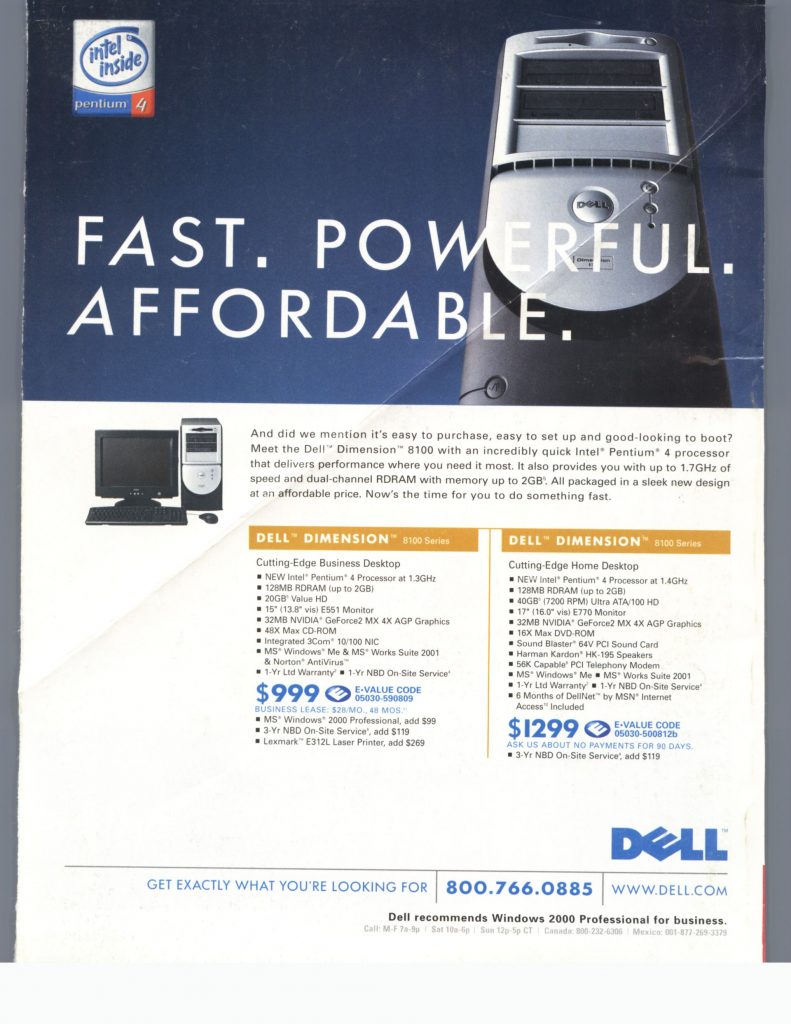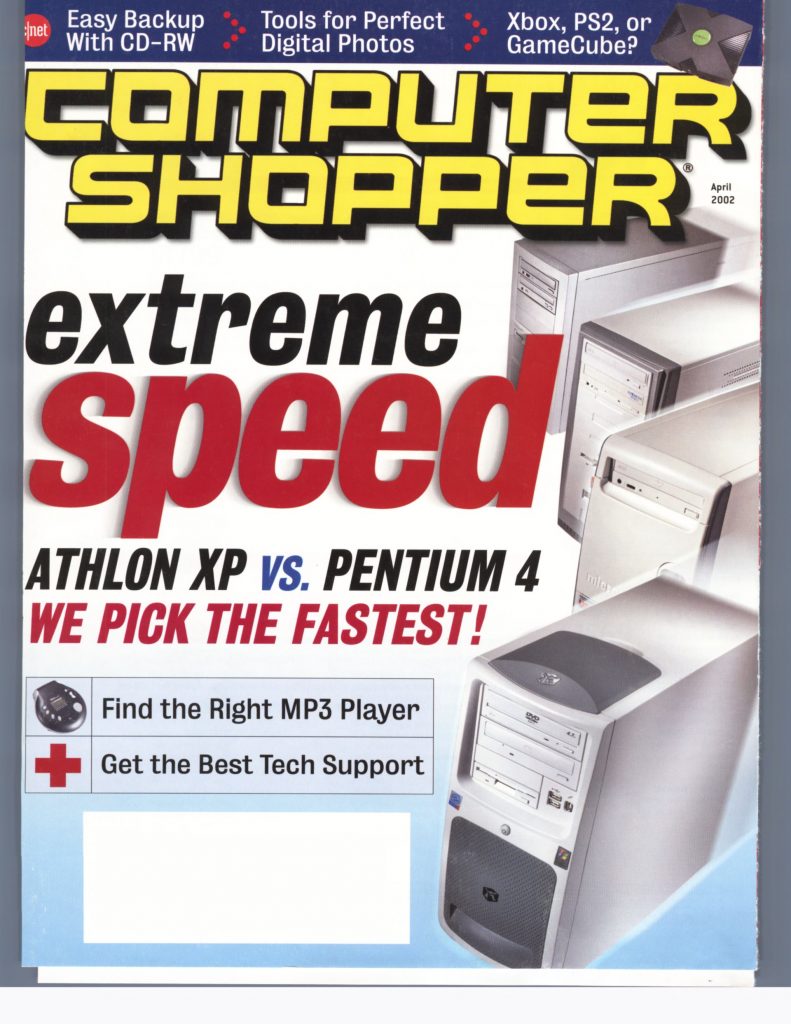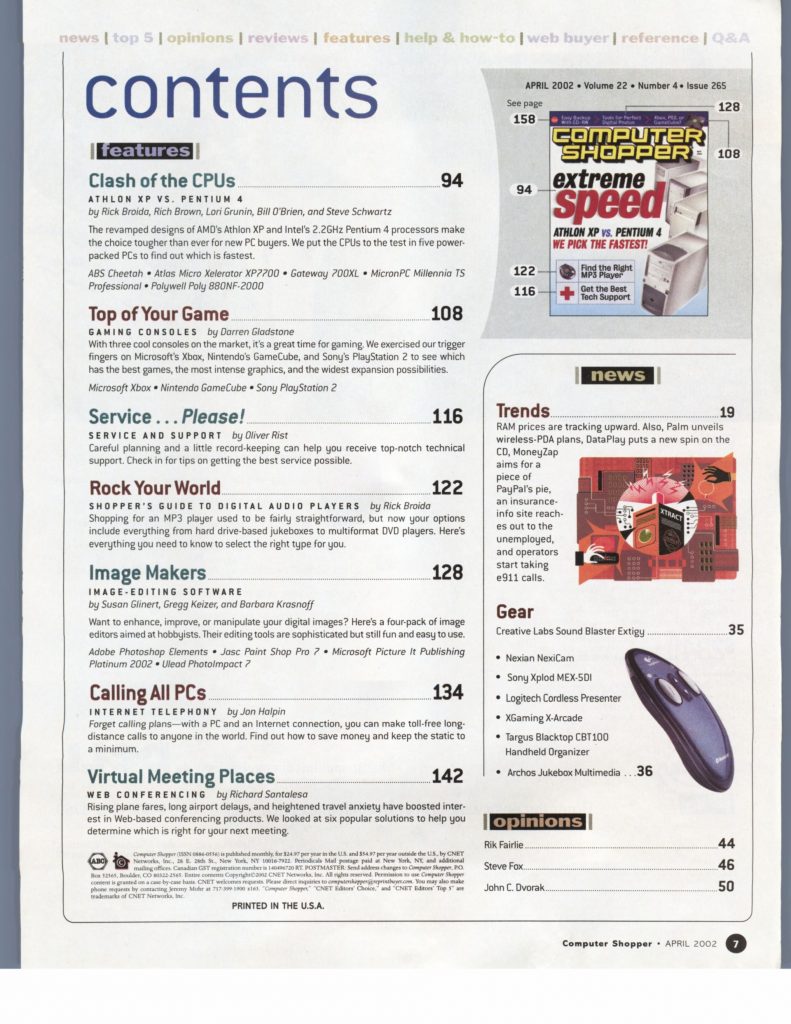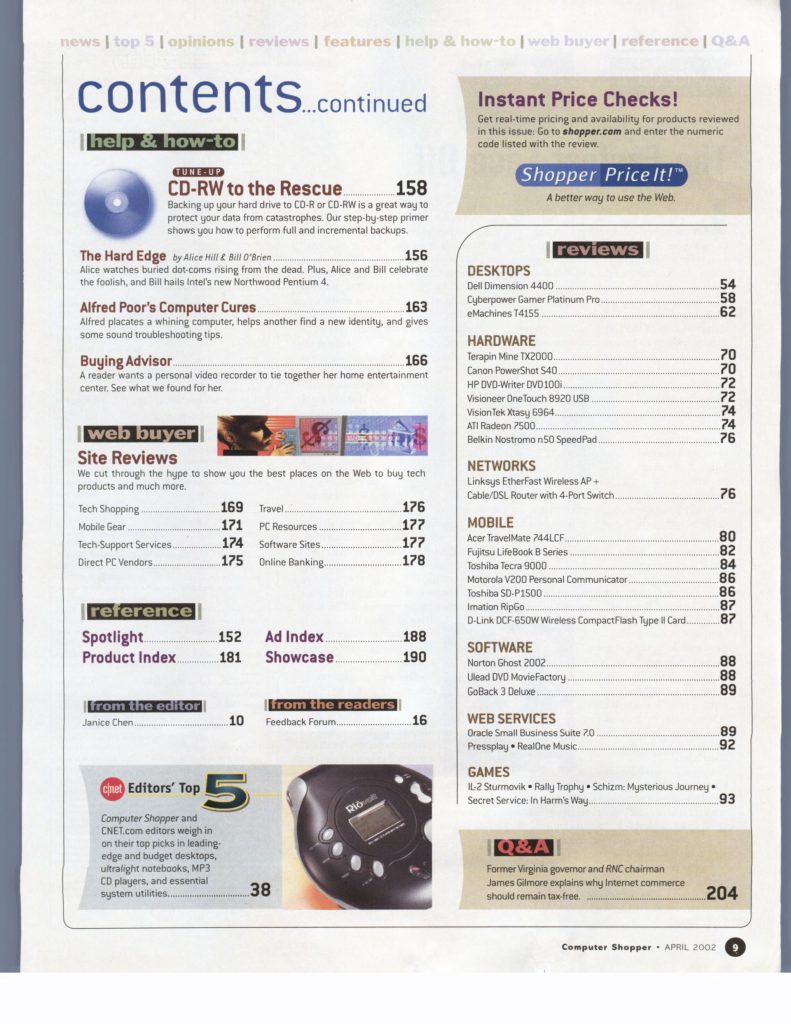
- Tag Archives Athlon XP
-
-
 Maximum PC (December 2001)
Maximum PC (December 2001)
Source: Maximum PC – December 2001
Maximum PC was by far my favorite computer magazine. It also survived longer than most with publication only ceasing a couple of years ago. When it was first introduced (in 1998 I believe) it was called boot. It was a magazine for enthusiasts and it reminded me a bit of MacAddict which was a similar sort of thing for Mac users. The December 2001 issue includes:
Regulars
- In/Out – Letters from readers about Hot Tamales (the candy), teen stereotypes, overclocking videocards, the G550, Windows XP, online privacy, gaming as a driver of the PC industry, and more.
- Quick Start – How September 11th changed PC gaming; IBM’s CPU of the Future, the dual core POWER4; Windows XP optimization tips; Intel’s plans for a 20 GHz chip; new Treo phones; wireless print server device that turns HP printers into wireless printers; mobile Pentium 4 to be introduced at 1.5 GHz and use DDR RAM; and more.
- Head2Head – A detailed comparison of the Pentium 4 2GHz and Athlon XP 1800+.
- Watchdog – IBM 75GXP hard drives seem to experience a high rate of failure; MaxGate stops responding to customers; some vendors refuse to support existing hardware with Windows XP drivers; Compaq recalls notebook power adapters; and more.
- Ask the Doctor – Troubleshooting a supposed Thunderbird Athlon identified as a Palomino; compatibility questions with the Asus A7V motherboard, Elsa Gladian 920 and Sound Blaster Live 5.1; troubleshooting vertical green lines on the screen; intermittent DSL disconnections; overclocking a Pentium III; and more.
- How To… – A guide to hosting a LAN party. Includes steps for insuring you have enough power, preparing ethernet cables and other networking gear, setting up a server, and more.
- Rig of the Month – A custom built machine featuring a Chinese “air” theme built around an ASUS CUV4X motherboard, Pentium III 733 (overclocked to 854 MHz), and AOpen GTS Pro PA256 Deluxe II 32MB video card (also overclocked).
Reviews
- Dell Dimension 8200 desktop system – A highly rated $3000 system from Dell that includes a 2GHz Pentium 4, 256 MB RDRAM, nVidia GeForce3 Ti 500, and more.
- Falcon Northwest Mach V system – A nearly $4000 gaming machine featuring an Athlon XP 1800+, 512 MB DDR RAM, nVidia GeForce3 Ti 500 64MB DDR, and more.
- TDK veloCD 16/10/40 external CD-RW drive – If you needed an external CD writer then this one was a good one to have.
- VisionTek Xtacy 6964 videocard – A highly rated video card using the GeForce3 Ti 500 chipset.
- OCZ Titan 3 videocard – Also highly rated but using the original GeForce 3 chipset.
- ATI Radeon 7500 videocard – A great card if you were looking for something on a budget.
- Sony DSC-S85 4.1 megapixel digi-cam – Digital snapshot cameras aren’t as popular as they once were but at the time they were far superior to phone cameras which barely existed.
- Olympus C-4040 4.1 megapixel digi-cam – Both this camera and the Sony model above were pretty average examples of what was available.
- Cambridge Soundworks Megaworks 210D 2.1 speakers – A decent set of 2.1 PC speakers.
- Philips MMS305 4.1 speakers – Another decent set of speakers but this one has a rear channel too.
- 3Com Bluetooth Wireless PC Card – A way to add bluetooth capability to your laptop which was not yet a common built-in feature.
- APC Back-UPS CS 500VA UPS – A highly rated UPS battery backup. APC is probably still the biggest name in UPSes today.
- Allen KEYKatcher device – A PS/2 passthrough device that captures keystrokes.
- Pocket Pyro PyroPro MP3 player – An MP3 expansion device for Palm devices that apparently was not well implemented.
- Red Faction – A pretty average first person shooter.
Features
- Gear of the Year – Some winners include the AMD Athlon XP 1800+ (CPU), Cooler Master ATC-101 (case), nVidia GeForce 3 (3D accelerator), Tyan Tiger MP S2460 (motherboard), Plextor PlexWriter 24/10/40 (CD-RW Drive), Pioneer DVR-A03 Recordable DVD/CD Combo (DVD Recorder), Creative Labs Nomad II MG (MP3 Player), Sony Clie PEG-N760C (PDA), Falcon Northwest Mach V (desktop system), Dell Inspiron i8000 (desktop replacement notebook), Sony F520 (monitor), May Payne (game of the year), and lots more.
- Rigs of the Year – A look at 15 machines custom built by readers with case mods.
- PC Gadget Guide – A look at some of the latest gadgets including the Microsoft Sidewinder Strategic Commander, DM2 Digital Music Mixer, Homer Simpson Dot-Pal Desktop Sidekick, Pentax Optio 430 Digital Camera, AfterBurner CD Labeling System, and more.

…and more!
-
 Digital Archaeology: Averatec 3200
Digital Archaeology: Averatec 3200
The Averatec 3200 was a low-end laptop model with an emphasis on DVD playback. While it seems to be reasonably well built, it does have quite a few limitations in order to cut costs. Having said that, if you were on a budget and it was sufficient for your needs at the time, it wasn’t a bad deal.

The Averatec 3200 featured a mobile Athlon XP processor which was essentially just a regular Athlon XP that ran at a lower voltage. These were highly desired by desktop builders because they would typically run at “normal” voltages and be excellent overclockers. It’s most direct competitor would have been a mobile Pentium 4 but by the time the Averatec 3200 came out there were better choices, mainly in the form of the Pentium M. It looks like the Averatec 3200 became available some time in late 2004 and was available at least at Best Buy, Sam’s, Newegg, Circuit City and Amazon and probably from other retailers as well. It looks like the configurations probably varied slightly depending on the retailer. For instance, the one I am using has an Athlon XP 2000+ whereas it looks like Newegg had one with a 2200+.

Some of the features of my particular model include:
- CPU: Athlon XP-M 2000+
- Video: VIA/S3 UniChrome with 32 MBytes of DDR SDRAM
- Screen: 12.1″ @ 1024×768
- Memory: 1 GB DDR PC2700 (This has likely been upgraded)
- Hard Drive: Hitachi 40GB E-IDE (ATA-6)
- Optical Drive: Slimtype COMBO SOSC-2483K DVD-ROM/CD-RW
- WiFi: MSI 802.11g MiniPCI Wireless Network Adapter
- Ethernet: VIA VT6102 Rhine II Fast Ethernet Adapter
Plus VGA port, 3 USB ports, and a single cardbus slot. For more complete specs see the output of HWiNFO here.

Limitations include the relatively limited number of ports plus the fact that there is only one memory slot so 1 GB is probably as far as the memory can be expanded in this laptop. Plus, the XP-M was kind of old tech at this point. As mentioned before the Pentium M was becoming the dominant mobile CPU at this time and in most cases they were as fast of faster than an XP-M would have been and they were certainly more energy efficient making for longer battery life.

However, the big advantage of this laptop was price. Depending on where you got it and the exact configuration, it cost around $1000 which was pretty cheap for the time. And while the Athlon XP-M may not have been the latest tech or the most energy efficient mobile processor, it was still reasonably powerful. The S3 Unichrome graphics were a slight upgrade to the S3 ProSavage and were not very good. But then you weren’t going to find strong graphics capabilities in any budget laptop, regardless of brand. The only real (relatively minor) complaint I have with this laptop is the keyboard. It actually feels pretty good for the most part but some of the keys are smaller than others making typing a little awkward. Fortunately, it only affects lesser used keys like the arrow keys, the greater than/less than keys, slashes and punctuation. I find myself hitting the wrong arrow key or the slash instead of an arrow (or vice versa). But overall, it’s a pretty small issue.

Drivers were somewhat problematic to find. I installed Windows XP and for the most part things worked fine. However, while the graphics were the proper resolution and color depth, screen draw was very slow until I tracked down the proper drivers which took a while. Also, Wi-Fi didn’t work out of the box either so I had to find those drivers as well. In addition, I had to track down sound and modem drivers (not that I really needed the modem). Most of these I had to track down by device ID as Averatec is no longer in business as far as I can tell and even if they were I doubt they would have drivers available to download for such old hardware. In theory, you should also be able to install a 32-bit version of Linux (but more RAM would be better).

The Athlon XP and Windows XP are still capable of running a variety of BOINC projects. So far it has processed work for Einstein@home, Asteroids@home, World Community Grid and MilkyWay@home. One oddity I noticed was the the laptop would sometimes freeze while running the screensaver or fail to wake up. I thought at first it might be a thermal issue but I disabled the BOINC screensaver (not the crunching itself, just the screensaver) and the problem was solved. There’s probably some issue with the relatively obscure Unichrome graphics and whatever the screensaver is doing. Or it could just be a driver issue but I think I’m using the latest that were available. At any rate, it works fine if I disable the screensaver or use a non-BOINC screensaver so it turns out not to be a big deal. In addition to the individual project links above, you can also see how this laptop is doing overall via BOINCStats or FreeDC.







